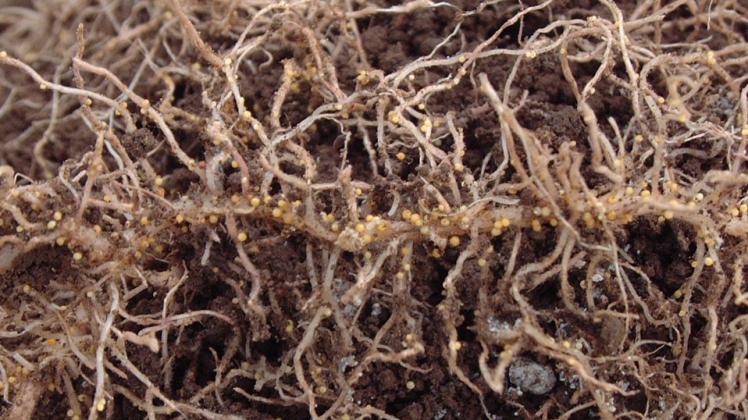Science: A triple relationship that incubates potato parasites is discovered
Potatoes produce a molecule that is transformed by microbes and causes parasites to hatch.

The discovery of this triple bond by Kobe University not only provides a new perspective on how plants interact with their environment, but also opens the door to developing countermeasures against the parasite.
The potato cyst nematode is a root parasite of plants such as potatoes and tomatoes that, if left untreated, can cause large-scale yield losses. Its eggs can survive in the soil for up to 20 years and hatch upon detecting certain molecules, called "hatching factors," secreted by the roots of the target species. Kobe University phytochemist Mizutani Masaharu says, "If we apply hatching factors to agricultural soils before planting, thereby inducing premature hatching of the parasites, this so-called ’suicide hatching’ could be an effective parasite control. However, this class of chemicals is difficult to identify because they are secreted in very small quantities."
The Kobe University researcher and his team previously discovered that, of the two known hatching factors, plants only secrete one, called solanoeclepin B (SEB), while soil microorganisms convert it into the other known form, called solanoeclepin A (SEA). He explains: "When we measured the reaction rate of the process, we noticed that the amount of SEB in the soil initially increased when we applied tomato root secretions to the soils. This led us to hypothesize that there must be another, previously unknown, molecule that the plants had produced and secreted. In the soils, we surmised, the soil microbes converted it into SEB and then into SEA." As experts in the interactions of plants with their soil environment, the team set out to identify the mysterious component and its environmental relevance with chemical detective work and genetic analysis.
In the journal New Phytologist, the Kobe University team now publishes the nature of the chemical, which they named "solanoeclepin C" (SEC), along with the discovery that this compound is secreted by plants 20 times more than the previously identified SEB. "Importantly, we were able to show that the newly identified SEC does not cause the parasites to hatch. However, it is converted in the soil to SEB as a decomposition process is dramatically accelerated by microbial action. This indicates that perhaps it is the secretion of SEC that is physiologically relevant to plants, but through the conversion of the chemical to SEB and then to SEA, the parasites are activated. This is the first time this type of tripartite relationship has been found for this class of chemicals," says Mizutani.
Las plantas suelen secretar sustancias químicas para atraer a los microorganismos del suelo y ayudarles a obtener agua o nutrientes a cambio de compuestos ricos en carbono. Una interacción similar podría ser la intención de la planta en este caso. Mizutani explica: «Al probar diferentes condiciones ambientales con las plantas, observamos que secretaban SEC y, en mucha menor medida, SEB, especialmente cuando carecían de nitrógeno o fósforo, nutrientes esenciales». Este es un patrón típico de las plantas que solicitan ayuda microbiana, y es posible que los parásitos se apropiaran de un efecto químico secundario de este sistema de llamada de emergencia. Sin embargo, el verdadero propósito fisiológico de la secreción aún queda por esclarecer en futuros estudios.
“A primera vista, un factor de eclosión parece ser un componente que solo tiene efectos adversos en la planta, y es curioso por qué lo producen. Pero esperamos con interés futuros trabajos que aclaren los efectos beneficiosos que esta clase de sustancias químicas tiene en las plantas”, afirma Mizutani. Respecto al uso de estas moléculas en la agricultura para inducir la eclosión suicida, el fitoquímico afirma: “Esta clase de sustancias químicas es estructuralmente compleja y, por lo tanto, difícil de producir. Pero si seguimos buscando, podríamos encontrar un equivalente con efectos similares y más fácil de producir”.
Financiación de esta investigación
Esta investigación contó con el apoyo de la Sociedad Japonesa para la Promoción de la Ciencia (subvenciones 24K01694 y 23K13885) y la Agencia Japonesa de Ciencia y Tecnología (subvención JPMJAX21B1). Se llevó a cabo en colaboración con investigadores del Centro RIKEN para la Ciencia de los Recursos Sostenibles, la Organización Nacional de Investigación sobre Alimentación y Agricultura y la Universidad de Hokkaido.
Publicación original
R. Akiyama et al.: Solanoeclepina C, una molécula secretada por la raíz que los microbios rizosferas convierten en factores de eclosión para los nematodos del quiste de la papa. New Phytologist (2025). DOI: 10.1111/nph.70252
Fuente: kobe-u.ac.jp










